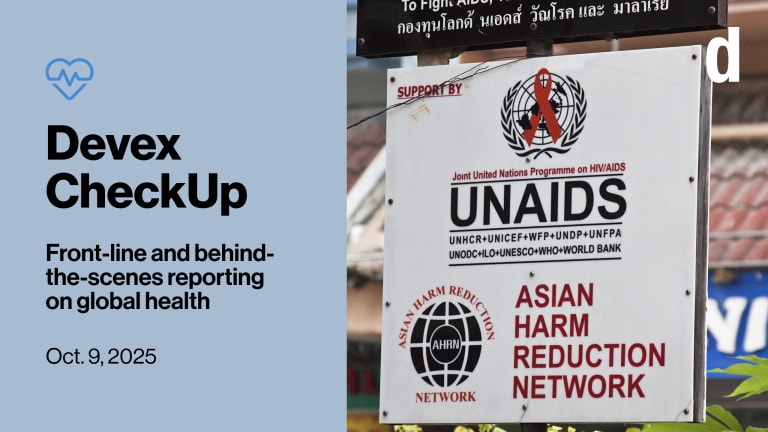
MANILA — The eight-day long 144th executive board session of the World Health Organization concluded earlier this month, but several key questions about next steps continue to hover.
From how a concrete strategy to handle WHO’s budget and partnerships will materialize, to what exactly the organization hopes to accomplish at the planned United Nations high-level meetings on universal health coverage in September, member states and some members of civil society returned home without much clarity.
More from the 144th WHO executive board session:
► Discord looms over WHO board meeting
► Tedros addresses alleged misconduct at WHO
► WHO's controversial next steps to improve access to medicines
Several controversial issues will also require follow-up, including the ongoing investigation into allegations of racial discrimination, abuse of authority, and fund mismanagement and WHO’s draft roadmap on access to medicines and much-debated cancer report. The latest evaluation of the organization’s health emergencies work, done in the midst of the ongoing Ebola outbreak in the Democratic Republic of the Congo, also received critical feedback from some member states.
In the lead up to the World Health Assembly in May, member states and civil society will demand answers from WHO on many of these issues, including details surrounding the organization’s internal reforms.
1. What’s the future of WHO and civil society engagement?
The prolonged gatherings have prompted questions in recent years on how the governing body meetings could be improved or shortened, and allow for richer discussions rather than a setup where each country representative delivers a statement on a particular topic within a time limit.
“We wouldn’t want anything that simply ‘checks the box’ for WHO.”
— Loyce Pace, executive director, Global Health CouncilBut proposals to make the discussions more efficient hit a nerve. Suggestions to limit the slots and time for civil society interventions created resentment, with civil society already feeling squeezed in their participation at the meetings.
Several WHO member states have voiced the need for them to have a more meaningful engagement with civil society via separate consultations outside the formal sessions. While the idea is “intriguing,” there is concern it may end up as just another U.N. forum lacking real government participation and designed solely to “appease, rather than include” civil society, said Loyce Pace, executive director at the Global Health Council.
“We wouldn’t want anything that simply ‘checks the box’ for WHO,” she said.
A representative of the Global Health Council cautioned during the meetings that any proposals to engage civil society should “supplement, not substitute” their already limited participation.
But the meetings ended with little clarity over how that meaningful engagement would look, with only a promise by the WHO secretariat and the board to further consult on the issue with civil society actors in the coming months.
2. Will WHO overcome its chronic budget woes?
About 75 percent of WHO’s budget is funded by earmarked voluntary contributions. This has led to some programs being adequately resourced, while others, such as noncommunicable diseases, suffer from chronic underfunding. The U.N. agency is also reliant on donor funding when it comes to its emergency operations.
WHO hopes to change that by appealing to donors to provide more flexible financing for its next budget cycle. Yet the budget breakdown it proposes for 2020-2021 is still heavily reliant on earmarked contributions. In fact, it states that its proposed increases for 2020-2021 — around $469.1 million — is expected to come from voluntary contributions.

WHO may also need to provide better clarity over its budget proposal. Member states asked the U.N. agency for some form of “cross-walk” that would allow them to compare the current budget to the next.
The U.N. agency has historically presented its budget by breaking down allocations and ceilings per program of work. But in its new proposal, the budget is broken down by strategic priorities and target outcomes as identified in its new strategic framework.
For example, under the strategic priority of 1 billion more people benefitting from universal health coverage, $971.6 million is proposed to achieve improved access to quality essential services; $106.7 million to reduce the number of people suffering financial hardships; and $301.3 million to improve access to essential medicines, vaccines, diagnostics, and devices for primary health care.
While it takes donors away from focusing on programmatic areas of interest, the ambiguity of where the funding will go doesn’t appeal to them either. As the representative from Monaco said: “The secretariat is suggesting we step out into unknown territory, but we need to understand where we’re going somehow. And we need clearly defined amounts for a number of activities.”
3. What does success look like for the U.N. high-level meeting on UHC?
It took the whole week of meetings for the draft resolution in preparation for the high-level meeting on universal health coverage taking place in September to be finalized. But some members of civil society have expressed concerns that the meeting may fall short of ambition, and lack clear lines of accountability when it comes to mobilizing the necessary resources for UHC. Some continue to seek clarity on how to bridge current global health investments with UHC objectives.
“A number of global health donors and implementers are still seeking an answer to a very important question around UHC. Namely, how do the new objectives dovetail with what we've come to invest in and focus on to advance global health in recent years? We live in a world of silos, which is reflected in how resources are mobilized and budgeted. I'm not sure the current resolution adequately addresses this critical outstanding question but it should,” said GHC’s Pace.
Some have also expressed concerns over the United States representative’s comments during the board sessions about dissociating itself from the part of the document pertaining to sexual and reproductive health.
“The meaning of [sexual and reproductive health] has evolved to include abortion, encouraging countries to change their laws on abortion, leading to a normalization of sexual activity as an expectation for teenagers,” the representative said. He reiterated U.S. continued investment in and support for family planning, but not abortion, an obvious allusion to the Mexico City policy or the “global gag rule” reinstated by U.S. President Donald Trump in 2017.
Sexual and reproductive health and related gender-related targets under Sustainable Development Goal 5 have been a contentious issue throughout the meetings. Their exclusion from the director-general’s progress report on the health-related SDGs, and in the initial drafts of the UHC high-level meeting resolution caused quite a stir on the floor and on social media.








